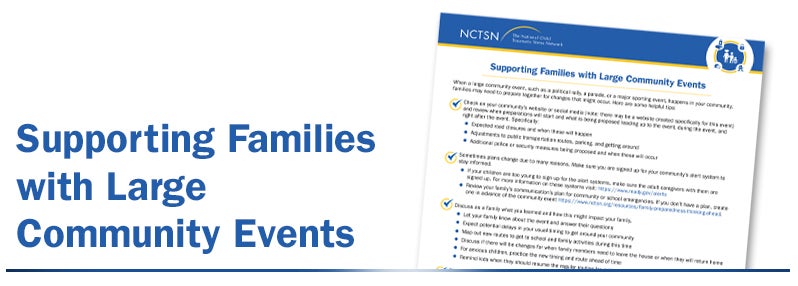


Supporting Families with Large Community Events
Provides information for parents and caregivers about how to support their family when a large community event is happening in their city or town. This fact sheet offers practical steps to support families who have experienced trauma who may become reminded of trauma or distressed when a large event comes to their community and helps families be prepared to support one another.
Supporting Military-Connected Youth in American Indian and Alaska Native (AI/AN) Communities Activity Guide
This partner-in resource from the National American Indian and Alaska Native Childhood Trauma Treatment Center provides activities designed to help military families navigate the often complex layers of Native, military, and other identities.

Child Welfare Trauma Training Toolkit
Supports caseworkers, supervisors, and all other levels of the child welfare workforce in implementing trauma-informed knowledge and skills in their daily interactions, professional services and organizational culture. The third edition of the Child Welfare Trauma Training Toolkit (CWTTT) incorporates two foundational trainings, a specialized skills training for supervisors and caseworkers, and a supervisor consultation series to enhance transfer of learning into day-to-day practice.

Youth Hate Crimes and Identity-Based Bullying Prevention Curriculum
From the Office of Juvenile Justice and Delinquency Prevention (OJJDP), this curriculum is a key component of the Preventing Youth Hate Crimes & Identity-Based Bullying initiative. The curriculum is designed to build protective factors in youth, change the attitude and behavior of young people who commit hate crime offenses, and help individuals working with these youth to better understand the potential of advanced communications technologies to break down cultural barriers and address bias.
Racial Training Module
From the Center for Safe and Resilient Schools, the Racial Trauma Module (RTM) is a psychoeducational module that can be delivered as a standalone module, as part of the Cognitive Behavioral Intervention for Trauma in Schools (CBITS) curriculum, or as an add-on to the Support for Students Exposed to Trauma: School Support for Childhood Trauma (SSET) curriculum. It provides youth with an overview of the effects of racism on levels of traumatic stress. In addition, the RTM provides school staff and adults with the foundational tools they need to acknowledge the effects of racism on youth by providing skills to create a space for students to talk about the impact of racism.
Healing Connections: A Community Approach to Childhood Trauma and Attachment
The Substance Abuse and Mental Health Services Administration (SAMHSA)’s ReCAST program supports youth and families impacted by gun violence and other trauma through implementation of evidence-based violence prevention, and community youth engagement programs, and linkages to trauma-informed behavioral health services. This report highlights lessons learned from SAMHSA’s ReCAST grant program to uplift the voices of communities impacted by violence as well as share strategies other communities can implement to promote healing, recovery and resiliency.
RECENT JOURNAL PUBLICATIONS
Racial and Ethnic Disparities in Age-Specific All-Cause Mortality During the COVID-19 Pandemic, authored Jeremy Samuel Faust, Benjamin Renton, Tasce Bongiovanni, Alexander Junxiang Chen, Karen Dorsey Sheares, Chengan Du, Utibe R. Essien, Elena Fuentes-Afflick, Trent Haywood,Rohan Khera, Terris King, Shu-Xia Li, Zhenqiu Lin, Yuan Lu, Andrew D. A. Marshall, Chima D. Ndumele, Ijeoma Opara, Tina Loarte-Rodriguez, Mitsuaki Sawano, Kekoa Taparra, Herman A. Taylor, Karol E. Watson, Clyde W. Yancy, and Harlan M. Krumholz, seeks to characterize overall and age-specific all-cause excess mortality by race and ethnicity during the COVID-19 public health emergency (PHE) and assess whether measured differences reflected changes from prepandemic disparities. This cross-sectional study analyzed data of all US residents and decedents during the COVID-19 PHE, aggregated by observed race and ethnicity (at time of death) and age. Statistical analysis was performed from March 2020 to May 2023. For the total population (all ages), the racial and ethnic groups with the highest observed-to-expected all-cause mortality ratios were the American Indian or Alaska Native and Hispanic populations. However, higher ratios were observed in the US population aged 25 to 64 years, greatest among the American Indian or Alaska Native, Hispanic, and Native Hawaiian or Other Pacific Islander groups. In the total population aged younger than 25 years, the Black population accounted for 51.1% of excess mortality, despite representing 13.8% of the population. In this cross-sectional study of the US population during the COVID-19 PHE, excess mortality occurred in all racial and ethnic groups, with disparities affecting several minoritized populations. The greatest relative increases occurred in populations aged 25 to 64 years. Documented differences deviated from prepandemic disparities.
Looking for Trainings?
Visit the NCTSN Training Page on LinkedIn
Not on our mailing list? Click here to sign up.
This project was funded by the Substance Abuse and Mental Health Services Administration (SAMHSA), US Department of Health and Human Services (HHS). The views, policies, and opinions expressed are those of the authors and do not necessarily reflect those of SAMHSA or HHS.
